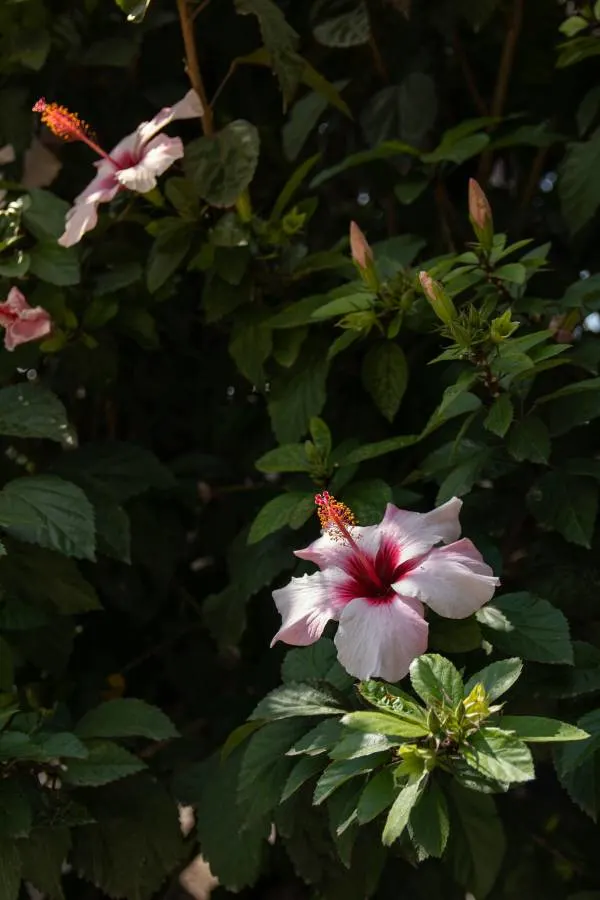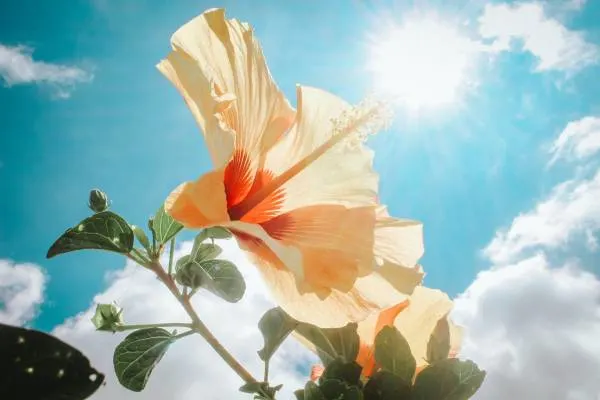Have you ever stopped to look at flowers and thought, “Wow, they are so pretty!”?
One such eye-catching flower is the Hibiscus. These beautiful flowers come in lots of different colors and have soft petals that scatter happiness in nature. But just like other mysteries of nature, this unique beauty has its secrets.
One thing people usually wonder about Hibiscus is what happens to flowers when it gets dark outside.
Do they close up like a book before bedtime?
Today, we will dive deep into answering this question.

Do Hibiscus Flowers Close at Night?
Yes!
Hibiscus flowers do close at night as a part of their natural behavior commonly called “Nyctinasty.” It happens because, in cold air and darkness, the bottom-most petals of these flowers grow faster than the upper-most ones.
This irregular growth allows the flower to shut without any problem.
Are Hibiscus Flowers Diurnal or Nocturnal?
I know you won’t be shocked to learn that Hibiscus flowers are diurnal. It means that these colorful flowers open during the day and close at night.
Just like many other nyctinastic plants, this behavior is a common characteristic of Hibiscus flowers. It allows them to adjust sunlight for photosynthesis during the day while conserving energy at night.
Now listen!
Some varieties of Hibiscus don’t follow this diurnal behavior and so prefer to open at night and close during the day—completely opposite!
Keeping both of these aside, there are also some varieties of Hibiscus present that can switch between diurnal and nocturnal behavior. These varieties open and close depending on the time of the day.
Pro Tip: If your Hibiscus shows both diurnal and nocturnal actions, give it additional sunlight or other light sources to support its needs.

Why Do Hibiscus Flowers Close at Night?
While it’s true that these flowers close in response to light, there is more to their behavior than meets the eye.
There are some other potential reasons behind their closure.
1. To Reduce the Risk of Freezing
Charles Darwin, the architect of the theory of evolution by natural selection, believed that certain plants close their flowers at night to reduce the risk of freezing.
And guess what?
Hibiscus is one of them. So when evening comes, you can see these pretty flowers close up to stay warm.
2. To Prevent Pollen From Getting Wet
Another reason behind the closing behavior of Hibiscus flowers is to prevent their pollen grains from moisture. This adaptation facilitates easy and effective pollen transfer by insects ultimately assuring the success of their reproductive cycle.
It’s just their self-preserving mechanism to maintain the dryness of their pollen grains.
3. To Conserve Energy
To conserve its energy, Hibiscus closes its flower during the night. It is essential because pollinating insects are active during the day, consuming a significant amount of their energy as they visit flowers.
By closing its flowers, Hibiscus can conserve its energy for continued growth and reproduction.
Factors Affecting the Closing of Hibiscus Flowers
Hibiscus flowers are popular for their colorful blooms.
While these flowers typically close at night, there are a variety of other environmental factors that influence the closing of Hibiscus flowers.
Let’s discuss some of the common factors in detail.
1. Temperature
The most important factor when it comes to the closing of Hibiscus flowers is temperature.
Being tropical plants, Hibiscus flowers feel comfortable in warm climates.
- Due to this reason, the petals will start to close up when the mercury drops below 60 degrees Fahrenheit.
- Contrarily, if the temperature rises above 85 degrees Fahrenheit, the petals will show the same protective response.
This is a natural response of Hibiscus flowers in response to protect themselves from extreme temperatures.
NOTE: When the temperature remains consistently warm and within the optimal range, the Hibiscus flowers remain open for even longer.

2. Humidity
The closing of leaves is also significantly influenced by the humidity levels.
Low humidity in the surrounding environment leads to the wilting and eventual closure of flowers. This occurs because the plants struggle to absorb moisture from the air.
Alternatively, when the humidity is high, petals close up to protect the plant from excessive moisture.
3. Wind
The wind, too, has joined the race.
When the delicate flowers are exposed to strong winds, the petals will close up to protect themselves from getting damaged.
4. Age
Apart from all the environmental factors, the natural aging process also affects the closing behavior of Hibiscus flowers. Young Hibiscus plants that possess flowers tend to close more quickly than older ones.
NOTE: These are a few factors that can impact the behavior of Hibiscus flowers. If any of these conditions are not met, the flowers can close earlier than usual.
Do Hibiscus Leaves Close At Night?
No, Hibiscus leaves don’t close at night. If you notice that your Hibiscus leaves are closing, it is probably due to stress condition.
The stress can be due to anything like:
- Heat
- Inadequate Watering
- Pests
Therefore, don’t compare the closing behavior of leaves with nyctinasty because the closing of Hibiscus leaves is a sign of problems.
That’s all for today!
Now it’s time to move toward the conclusion.
Conclusion
Hibiscus flowers close at night through the phenomenon of nyctinasty.
Most of the varieties of Hibiscus flowers are diurnal. However, there are some varieties that show completely opposite behavior—nocturnal, while some of them show both behaviors depending on the time of the day.
Hibiscus flowers usually close in response to light, but there are many other environmental factors like temperature, humidity, and wind that contribute to the process.
I hope this post helps you a lot.
If you like this post, don’t forget to share it with your friends.
Regards!
